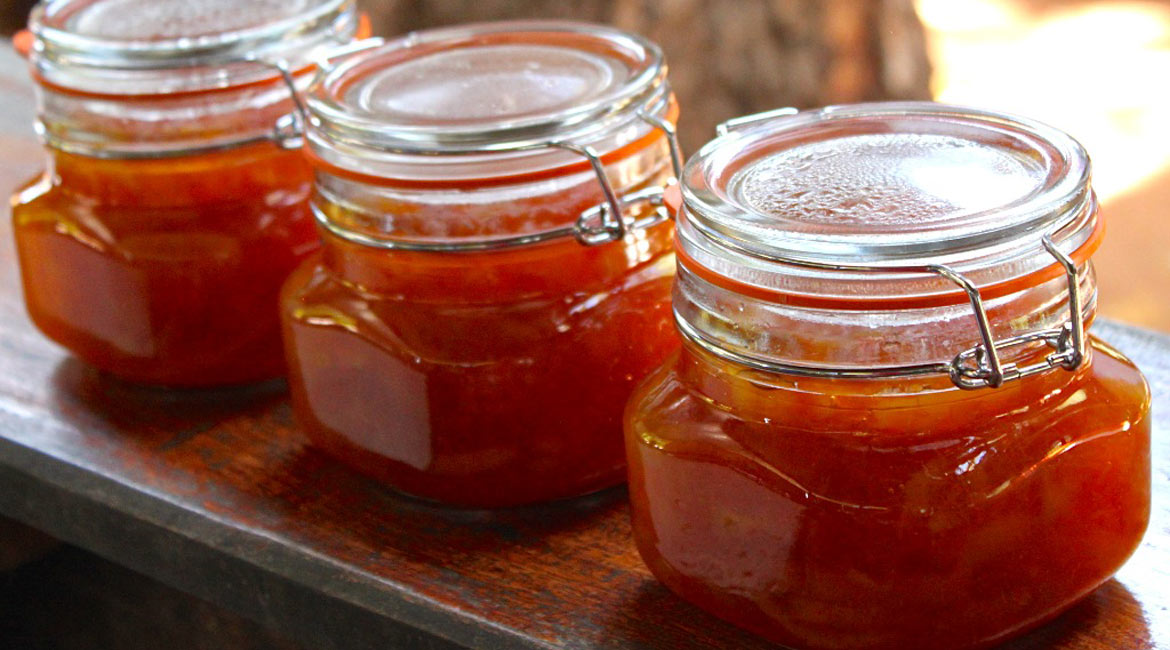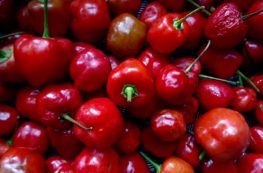While planning this post, I realized I had no idea where or how food preservation began. I started exploring its history and read that although food has been preserved for millennia — from early man having to harness nature to survive i.e. storing fish on a bed of ice — it was a French confectioner in the late 1700s who invented the canning techniques we still use today.
In an article by the National Center for Home Food Preservation, I learned that Nicolas Appert discovered how applying heat to food in sealed glass bottles preserved it from deterioration. He theorized “if it works for wine, why not foods?” The French Navy later offered itself as a guinea pig for Appert’s principles, and in 1806 they were successfully trialled on a wide range of foods including meat, vegetables, fruit and milk.

Because we don’t have harsh winters here in the Zambezi Valley, preserving food is not really a necessity. We can usually find something to eat out of the ground any time of year. By filling our pantry with preserves, I’m sating my inner Amish housewife: I hate waste, and I love saying “… it’s out of the garden.”
Canning jars come and go quickly in our shops. If I see them, my inner Amish housewife is elbowed aside by my Black-Friday-Sales housewife and I’ll try and grab the lot. That said, we give many away as gifts, so there are times when we have to make do with reusing our old jars. Often the lids are compromised — the seals give way, or they rust — and if I’m unsure, especially in our searing summer months, I’ll store our preserves in the fridge instead of the pantry.
In this post I have highlighted some of the preserves we’ve made in the last couple of months. These include Rosella Jelly, David Lebovitz’s Kumquat Marmalade, Pilipili-Hoho, Pomelo Preserve, Roasted Peppers in Garlic OIive Oil, and Whole Preserved Kumquats. I have not included my Preserved Lemons or Marula Jelly, both of which I wrote about in earlier posts this year.
Rosella, or Wild Hibiscus, Jelly



Ingredients:
- Rosellas
- Water
- Granulated sugar
Method:
- Separate the seedpods from the calyxes into two bowls. Rinse well in cold water and then drain. (The setting agent, or the pectin, in rosellas is in the seedpods.)
- Transfer the seedpods to a heavy-based saucepan, cover them with water, and bring to the boil. Turn down the heat and simmer the seedpods until they are soft, about an hour.
- Remove from the heat, strain the pods, and save the liquid to pour over the rosella calyxes in a separate saucepan. The seedpod water should just cover the rosella calyxes. Bring to the boil and then simmer until the calyxes are soft and breaking apart, about an hour.
- Remove from the heat, strain out the calyxes, and save the dark red liquid to measure its volume. Add an equal amount of sugar to liquid: 1 cup of calyx liquid = 1 cup of sugar.
- Return to the heat, bring to the boil, and cook until the sugared syrup starts to turn to jelly, about 45 minutes. Stir occasionally. (For those without a jelly thermometer, like me, place a small plate into the freezer while the jelly/jam is boiling. You will see how the consistency changes, and when you think it’s ready, turn off the heat. Spoon a little of the jelly onto the cold plate and return to the freezer for a couple of minutes. If it wrinkles, or if your finger leaves a track through the jelly, it is ready.)
- Remove from the heat, cool slightly, and transfer to sterilized jars. Click here to read how I sterilized jars when I made guava jelly last year.

David Lebovitz’s Kumquat Marmalade
I have used this recipe a few times to make Kumquat Marmalade. In taste it’s unbeatable; in consistency I find it a little runny. To help this last batch set firmer, I added some big chunks of pomelo skin, which is packed with pectin, and it made all the difference. After it had done its job, I removed the pomelo skin from the marmalade. Click here to read the recipe.



Pilipili-Hoho
I wrote about Pilipili-Hoho in one of my first posts on SavannaBel. It’s a hot, boozy sauce I add to soups, stir-frys, curries, and sautéed chicken livers, especially in the colder months. It’s bright and cheerful looking, and also makes a terrific holiday gift. Click here to read the post and the recipe.


Pomelo Preserve
The pomelo, aka shaddock, aka pampelmousse, aka Chinese grapefruit makes a chunky, mild and moreish preserve. We have juiced pomelos, and eaten them fresh for breakfast, but I’d never cooked this football-size fruit before. The pectin is in the pomelo’s skin and dense pith, while its flavor can be found in the coral-pink segments. Click here for the recipe I adapted to make my Pomelo Preserve. I say “adapted” because I didn’t follow the recipe word-for-word. I never chopped up the whole fruit in a processor, for instance; instead I set the pink pulp aside and separated some of the skin from the pith, which I sliced neatly into thin strips before boiling. I also added 2 cups of water to the fruit and sugar mix before boiling it into Pomelo Preserve.



Roasted Peppers in Garlic Olive Oil
When we were given a bagful of red, green and yellow peppers by a farmer next door recently, I knew we couldn’t eat them all so chose to roast and preserve them in garlic and olive oil instead. I did not use a recipe as such. I sliced the peppers neatly, removing the seeds and the ribs. I then blackened the peppers’ skin in a hot cast-iron skillet, which one can do in the oven or over a flame if it’s easier. I did this in batches because of the quantity. When the peppers were charred and softened, I transferred them to an airtight bag to sweat. When cool enough to handle, I peeled off the blackened skin, layered them in a canning jar, covered them with olive oil, added a couple of fine slices of garlic, and sealed. That was it. Done. Once opened, I kept the peppers refrigerated.
We ate them in frittatas, in salads, in quinoa, and on their own. In this house roasted peppers don’t last long at all. When the peppers were finished, I used the leftover sweet-perfumed, smoky garlic oil to enhance a dish of roasted vegetables, as well as a salad dressing.


Preserved Whole Kumquats
Whole kumquats in syrup make a delicious accompaniment to cheese, especially a gorgonzola or Stilton. They are also complemented by roasted nuts, like almonds or pecans — some people stuff them inside the preserved kumquats — and can be used in cakes, steamed puddings, or ice cream. While preparing these kumquats I was left with a surplus of syrup, which I decided to bottle as a cordial. Kumquat cordial adds a warm citrus flavor to a hot whiskey, yet is also refreshing when topped with soda water, ice and a sprig of mint. Click here for the recipe, taken from an article in the Fresno Bee published in 1971.





12 Comments
Thank you for the history lesson at the beginning of the post. I look forward to making the Hibiscus and pilipili-Hoho jellies.
Hi Mundia … it’s my pleasure! I found the history of canning very interesting, too. Thank you for stopping by my blog, and all the best to you … Annabel
You could be a home ec teacher! Oh I want to make the kumquat one.
Haha, Michelle! I don’t think so … I’m not very good at following rules! That said, I’ve been asked to introduce some cooking classes around here so you never know … 😉 We’ve had such a huge harvest of kumquats off this one little tree, so this coming week I’m going to make those pecan kumquat tarts about which you wrote in a recent post. They looked and sounded so good!
What beautiful pictures! The kumquat marmalade is something I am going to have to try…we have a lot of kumquats around here! Thanks for sharing and the history of canning was such a nice bonus! 🙂
Thank you so much for your kind comment. I highly recommend the kumquat marmalade, to be sure. I’d never worked with kumquats before I moved here. They are unusual and oh so tasty. Thanks for stopping by my blog, and all the best to you … Annabel
Strange question now, but I think you would be the one to ask…..What are the best things to see and do in Livingstone. (Apart from the obvious!) My friend is coming for a wedding, but she always likes exciting and educationl stuff to do. I suggested the Museum, Game Park, of course the Falls and Craft stalls, but what would you, as a local, wouldnt want us to miss?
LOVE YOUR BLOG. We grew up on the airport Road opposite the hospital, and I STILL miss Livingstone. We had a Mugongo Nut in the garden, and it brought back such memories, like when elephants spent a day in the David Livingstoen school playing fields. All the various departments were called in to decide what to do, when a little Fox Terrier rushed, in yapping at their heels, and they took off, tails curled over their backs in fear of the little white peril. Through the Grave yard, down the road and back into the bush. Great place to grow up.
Thank you for your kind comment, Jane. Livingstone is indeed a unique and wonderful place. I love living here …
As for your friend, depending on what time of year she is coming, I highly recommend Livingstone Island for afternoon tea, and Devil’s Pool, where she can swim right next to the edge of the Falls (it’s a package). This is seasonal because of the rains and the water levels. There is, of course, all the adventure tourism beneath the Falls, as well as a rhino walk in the Mosi-o-Tunya National Park. I loved the latter … we walked very close to nine protected rhino in the park, which was just great. All the best to you … Annabel
[…] the oven to 180/350 degrees. Roast the red and yellow pepper slices. (Click here to see how I roast peppers; this time, because of the small quantity, I roasted them over a naked […]
[…] Roasted peppers in olive oil and garlic. […]
Nice, am enjoying ur work
Thank you! 🙂
Comments are closed.